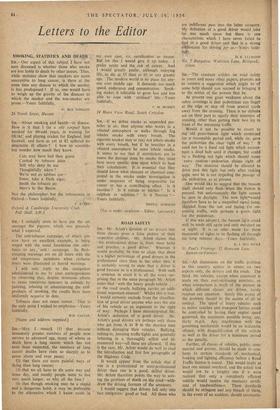ROAD SAFETY
SIR,—Mr. Arlott's division of car drivers into three classes gives a false picture of their respective abilities. Mr. Arlott claims that ' the professional driver is, from sheer habit and practice, a good driver.' Whereas it would probably be true to claim that there is a higher percentage of good drivers in the professional class than in the other two, it is certainly wrong to state that a driver is good because he is a professional. With such a sentence in mind it is all the more sur- prising that in the same paragraph Mr. Arlott states that with the heavy goods-vehicle . . . • or the road coach, bullying carries an addi- tional important element.' Whilst this is true, I would certainly exclude from the classifica- tion of goad driver anyone who uses the size of his vehicle as an argument to the right of way. Perhaps I have misinterpreted Mr. Arlott's definition of a good driver. Mr. Arlott's good drivers are perhaps only those who get from A to B in the shortest time without damaging their vehicles. Bullying, cutting-in, jumping traffic-lights and generally behaving in a 'thoroughly selfish and ill- mannered way—all these are allowed. If this is the case, Mr. Arlott would do well to read the introduction and first few paragraphs of the Highway Code.
It would appear from the article that if one is a professional or semi-professional driver then one is a good, skilful driver. Mr. Arlott therefore points the way to solv- ing the problem of death on the road—with- draw the driving licences of the amateurs.
are indifferent pass into the latter category. My definition of a good driver would take far too much space but there is one characteristic which I have never failed to find in a good driver and that is a strong efithusiasm for driving per se.—Yours faith- fully.
D. K. LI LIM ANN No. 2 Bungalow, Waterton Lane, Bridgendo Giant.


































 Previous page
Previous page